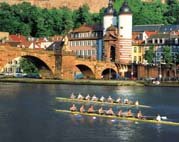The city of Heidelberg

The City of Heidelberg is located where the Neckar river enters the wide valley of the Rhine river. The Neckar valley is steep and the many houses in Heidelberg are glued to the steep walls of the valley. On the other hand the forested mountains along the valley provide a cosy 400 m high green curtain around the Old Town of Heidelberg. Due to its low altitude and the influence from the Rhine valley the climate in Heidelberg is moderate. However, it is remarkable that even if you have a foggy or rainy autumn day in downtown Heidelberg (where e.g. the ITA or the ARI is located), the top of the Koenigstuhl mountain (where you find the MPIA and the LSW) is above the clouds and enjoys beautiful bright sunshine. Heidelberg provides best shopping facilities for all goods and at all price levels. Unfortunately, the latter is not true concerning the student accommodation, in particular downtown. The cheapest way to live is to share an apartment with other students. A room in such a "Wohngemeinschaft" costs about 300 Euro / month. The public transportation system is of best European standard and allows you to reach downtown Heidelberg from its suburbs in general in about 10-20 min. Bicycling is the usual way of student transportation, but (because of that) it could be sometimes hard to find a parking lot for your bike ...

Heidelberg is an old town with a history going back to 1155 when the oldest castle and the settlement came into the possession of the Hohenstaufens under Palgrave Konrad. The name "Heidelberch" is mentioned in a document for the first time in 1196. In 1622 the imperial general Tilly conquers the town and palace in Heidelberg. In 1623 the imperial forces carry off the famous "Palatinate Library" (Biblioteca Palatina, today at the Vatican) as war-booty. The Palatinate looses three-quarters of its population in the war. In 1688/89 the French troops take Heidelberg in the course of the War of Palatinate Succession and destroy the Palace, the town and villages and towns in the Rhine valley before retreating. The present mayor hall was built 1701. The first railway connection in the State of Baden is inaugurated 1840 and connects Heidelberg with Mannheim (20km). Heidelberg is the home town of Friedrich Ebert, the first "Reichspraesident" of the democratic "Deutsches Reich" (born 1871, burried 1925 at the Bergfriedhof). From 1925-1929 the Neckar River has been canalized, and 1935 the "Autobahn" Frankfurt-Mannheim-Heidelberg was opened. Fortunately, the city of Heidelberg survived the second world war undamaged when 1945 the city has been turned over to American military leaders. A complete rehabilitation of downtown Heidelberg begun in 1972. The car-free pedestrian zone in the Old Town has been completed 1979. More recent celebrations have been the 600-year anniversary of the University of Heidelberg 1986 and the 800-year anniversary of the City of Heidelberg.
This is what Mark Twain has written about Heidelberg Castle in his 1880 travel book A Tramp Abroad:
A ruin must be rightly situated, to be effective. This one could not have been better placed. It stands upon a commanding elevation, it is buried in green woods, there is no level ground about it, but, on the contrary, there are wooded terraces upon terraces, and one looks down through shining leaves into profound chasms and abysses where twilight reigns and the sun cannot intrude. Nature knows how to garnish a ruin to get the best effect. One of these old towers is split down the middle, and one half has tumbled aside. It tumbled in such a way as to establish itself in a picturesque attitude. Then all it lacked was a fitting drapery, and Nature has furnished that; she has robed the rugged mass in flowers and verdure, and made it a charm to the eye.
The standing half exposes its arched and cavernous rooms to you, like open, toothless mouths; there, too, the vines and flowers have done their work of grace. The rear portion of the tower has not been neglected, either, but is clothed with a clinging garment of polished ivy which hides the wounds and stains of time. Even the top is not left bare, but is crowned with a flourishing group of trees & shrubs. Misfortune has done for this old tower what it has done for the human character sometimes - improved it.

